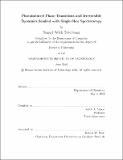| dc.contributor.advisor | Keith A. Nelson. | en_US |
| dc.contributor.author | Teitelbaum, Samuel Welch | en_US |
| dc.contributor.other | Massachusetts Institute of Technology. Department of Chemistry. | en_US |
| dc.date.accessioned | 2016-10-25T19:16:47Z | |
| dc.date.available | 2016-10-25T19:16:47Z | |
| dc.date.copyright | 2016 | en_US |
| dc.date.issued | 2016 | en_US |
| dc.identifier.uri | http://hdl.handle.net/1721.1/104978 | |
| dc.description | Thesis: Ph. D., Massachusetts Institute of Technology, Department of Chemistry, 2016. | en_US |
| dc.description | This electronic version was submitted by the student author. The certified thesis is available in the Institute Archives and Special Collections. | en_US |
| dc.description | Cataloged from student-submitted PDF version of thesis. | en_US |
| dc.description | Includes bibliographical references (pages 225-237). | en_US |
| dc.description.abstract | Single-shot femtosecond spectroscopy was developed to study irreversible processes and materials far from equilibrium. It was then applied to investigate photoinduced phase transitions in semimetals and manganites. The dual-echelon single-shot instrument was developed, and noise sources, experimental artifacts, and the fundamental limits of the single-shot technique were explored. In this thesis, advances in the single-shot technique that allow for more detailed investigation of material processes and characterization of far-from-equilibrium dynamics in a wider range of systems are discussed. Experiments and modeling of photoinduced phase transitions in two classes of systems, semimetals and manganites, are presented. Both systems show collective structural change under photoexcitation that ultimately results in a low-symmetry to high-symmetry phase transition. In semimetals, the high symmetry phase relaxes after a few picoseconds, and in manganites, the higher symmetry phase persists essentially indefinitely. A photoinduced structural phase transition in bismuth is discussed in terms of the removal of a Peierls distortion by electronic excitation. When more than 2% of the valence electrons are excited, the Peierls distortion is inverted and the bismuth crystal is collectively driven into a symmetric crystalline phase. An extended two-temperature model is used to interpret and identify a photoinduced symmetric phase that exists above the damage threshold at low temperature and high excitation density. Analogous experiments and analysis on antimony and tellurium are discussed, demonstrating the generality of this method to exploring phase transitions in Peierls-distorted systems. A recently discovered photoinduced insulator-to-metal phase transition in epitaxially strained La₂/₃Ca₁/₃MnO₃ on an NdGaO₃ (001) substrate at low temperature is characterized by frequency-domain and time-domain spectroscopy. The ground state and metastable photoinduced phase in LCMO are characterized by their steady-state behavior. Conventional pump-probe and single-shot experiments are interpreted in terms of an eective medium model that describes the density of charge transfer excitations in the material. An extended two-parameter Ginzburg-Landau model with biquadratic coupling describes the ground state of the manganite phase diagram and the stability of the photoinduced metallic phase. | en_US |
| dc.description.statementofresponsibility | by Samuel Welch Teitelbaum. | en_US |
| dc.format.extent | 237 pages | en_US |
| dc.language.iso | eng | en_US |
| dc.publisher | Massachusetts Institute of Technology | en_US |
| dc.rights | M.I.T. theses are protected by copyright. They may be viewed from this source for any purpose, but reproduction or distribution in any format is prohibited without written permission. See provided URL for inquiries about permission. | en_US |
| dc.rights.uri | http://dspace.mit.edu/handle/1721.1/7582 | en_US |
| dc.subject | Chemistry. | en_US |
| dc.title | Photoinduced phase transitions and irreversible dynamics studied with single-shot spectroscopy | en_US |
| dc.type | Thesis | en_US |
| dc.description.degree | Ph. D. | en_US |
| dc.contributor.department | Massachusetts Institute of Technology. Department of Chemistry | |
| dc.identifier.oclc | 959713657 | en_US |
